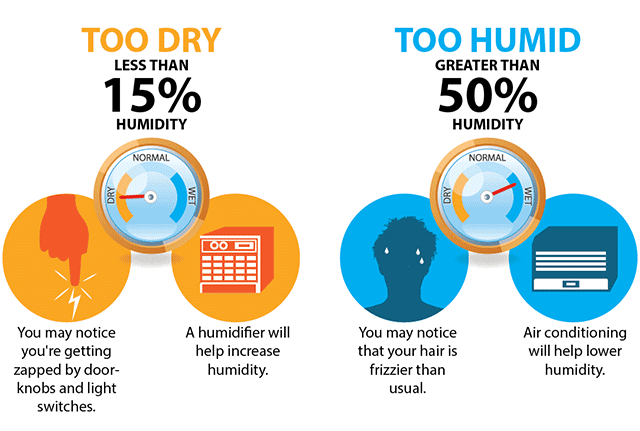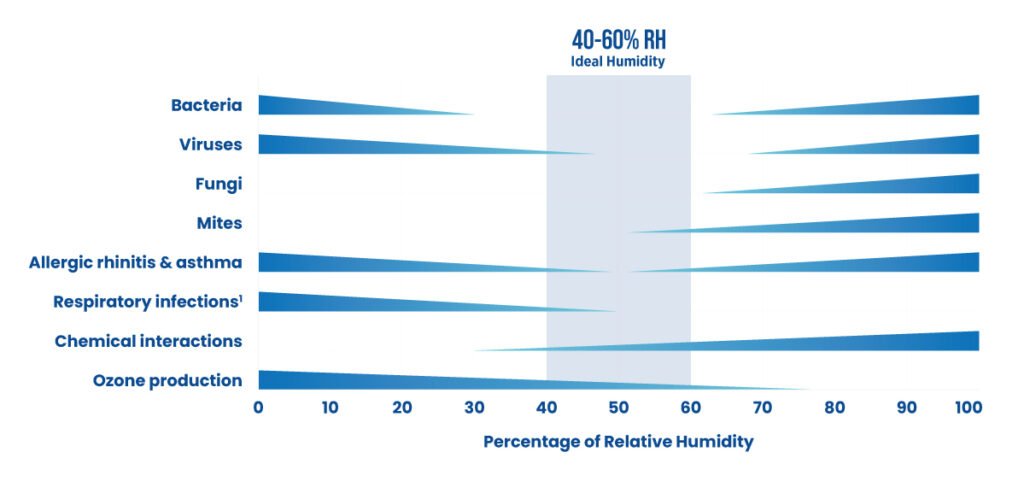
It’s important to find the sweet spot when it comes to the humidity levels in your home. Too much humidity can lead to condensation, mold growth, and discomfort, while too little can cause dry skin, irritated eyes, and even respiratory issues. So, what is the ideal humidity level for your home? This article will provide you with all the information you need to understand and achieve the perfect balance for a comfortable and healthy living environment.

This image is property of cms.airthings.com.
1. Introduction
Maintaining the ideal humidity level in your home is essential for your comfort and overall well-being. Humidity refers to the amount of moisture in the air, and it can greatly impact your living environment. In this article, we will explore the importance of the ideal humidity level, the effects of high and low humidity, the optimal humidity range for different seasons, how to measure humidity, ways to control and maintain ideal humidity, the health benefits of proper humidity, and common home humidity problems and solutions.
2. Importance of Ideal Humidity Level
Maintaining the ideal humidity level in your home is crucial for several reasons. First and foremost, it affects your overall comfort. Excessive humidity can make the air feel heavy and oppressive, while low humidity can lead to dryness and discomfort. Additionally, the ideal humidity level is vital for preserving your home and its contents. High humidity can cause condensation on windows, leading to mold and mildew growth, while low humidity can cause wood to crack and warp. Lastly, proper humidity levels can promote better indoor air quality and contribute to your overall health and well-being.
3. Effects of High Humidity
High humidity levels can have various negative effects on your home and health. Excessive moisture in the air can create the perfect breeding ground for mold and mildew, leading to respiratory issues and allergies. High humidity can also cause condensation on windows, leading to water damage and potential mold growth. Additionally, it can make your living space feel uncomfortable and stuffy, making it harder to relax and sleep.
4. Effects of Low Humidity
On the other hand, low humidity levels can also have adverse effects. Dry air can lead to dry and itchy skin, irritated eyes, and respiratory problems. It can also exacerbate allergies and increase your susceptibility to respiratory infections. Furthermore, low humidity can cause wood furniture, flooring, and musical instruments to crack, warp, or shrink, compromising their durability and aesthetics.

This image is property of www.newcombandcompany.com.
5. Optimal Humidity Range for Different Seasons
The optimal humidity level for your home varies depending on the season. Let’s take a look at the recommended humidity range for each season:
5.1. Winter
During the winter months, when the temperature drops, it is essential to maintain a humidity level between 30% and 40%. This range will help prevent excessive dryness, which can lead to respiratory issues and dry skin. Using a humidifier in your home can help achieve and maintain the ideal humidity level during winter.
5.2. Summer
In the summer, when outdoor humidity levels tend to be high, it is recommended to keep your indoor humidity level between 40% and 50%. This range helps prevent excessive moisture, which can cause mold growth and promote the spread of allergens. Proper ventilation and the use of dehumidifiers can help control humidity levels during the summer.
5.3. Spring
During the spring season, the optimal humidity range for your home falls between 30% and 50%. This range allows for a comfortable living environment and minimizes the risk of mold growth. It is essential to monitor and adjust humidity levels as needed using hygrometers or digital indoor thermometers.
5.4. Autumn
In autumn, when the weather starts to cool down, a humidity level between 40% and 50% is recommended. This range helps maintain comfortable conditions while minimizing the risk of mold and mildew growth. Regular monitoring of humidity levels and adjusting ventilation as necessary is key to ensuring optimal conditions during this season.
6. How to Measure Humidity
To maintain ideal humidity levels in your home, it is important to be able to accurately measure the humidity. Here are two commonly used methods for measuring humidity:
6.1. Hygrometers
Hygrometers are devices specifically designed to measure humidity levels. They are available in analog or digital forms and can be used in different parts of your home. Hygrometers provide real-time readings, allowing you to monitor and adjust humidity levels accordingly.
6.2. Digital Indoor Thermometers
Some digital indoor thermometers also come with built-in humidity sensors, allowing you to measure both temperature and humidity with a single device. This can be a convenient and cost-effective option for monitoring humidity levels in your home.

This image is property of www.budgetohio.com.
7. Controlling Humidity in Your Home
Maintaining ideal humidity levels in your home involves actively controlling and managing moisture levels. Here are some effective ways to control humidity:
7.1. Proper Ventilation
Proper ventilation is crucial in controlling humidity levels. Ensure that your home has adequate airflow by using exhaust fans in bathrooms and kitchens, opening windows when weather permits, and utilizing ventilation systems. This will help remove excess moisture and prevent the buildup of humidity.
7.2. Use of Dehumidifiers
Dehumidifiers are devices designed to remove excess moisture from the air. They are particularly useful in humid climates and during the summer months. By extracting moisture from the air, dehumidifiers can help maintain optimal humidity levels in your home.
7.3. Use of Humidifiers
Humidifiers, as the name suggests, add moisture to the air. They are beneficial in dry climates or during the winter months when humidity levels tend to drop. Adding humidity to the air can alleviate dryness, help with respiratory issues, and create a more comfortable living environment.
8. Tips for Maintaining Ideal Humidity
In addition to actively controlling humidity levels, here are some tips to help you maintain the ideal humidity in your home:
8.1. Regular Cleaning and Maintenance
Keeping your home clean and well-maintained can contribute to better humidity control. Regularly cleaning and inspecting areas prone to moisture buildup, such as bathrooms and basements, can help prevent mold and mildew growth.
8.2. Utilize Natural Remedies
Certain natural remedies can help regulate humidity levels in your home. For example, strategically placing bowls of water or plants can help add moisture to dry air, while using moisture-absorbing materials like charcoal or baking soda can help reduce excess moisture.
8.3. Avoid Overwatering Plants
Indoor plants add beauty to your home and can help regulate humidity levels. However, overwatering plants can increase humidity. Be mindful of the water needs of your plants and avoid watering excessively, especially in areas with high humidity levels.
8.4. Hanging Clothes to Dry
Instead of using a dryer, consider hanging your clothes to dry indoors. This can add moisture to the air and increase humidity levels, especially during dry seasons or in areas with low humidity.
8.5. Sealing Air Leaks
Air leaks, such as gaps around windows and doors, can allow moisture to enter your home. Seal any air leaks to prevent excess humidity from entering and preserve your ideal humidity levels.

This image is property of www.cielowigle.com.
9. Health Benefits of Maintaining Proper Humidity
Maintaining proper humidity levels in your home can have various health benefits. Adequate humidity can help alleviate symptoms of dry skin, dry eyes, and respiratory issues such as allergies and asthma. It can also promote better sleep by creating a more comfortable and soothing environment. Furthermore, reducing excessive humidity can help prevent the growth of mold and mildew, which can trigger respiratory issues and allergies.
10. Common Home Humidity Problems and Solutions
Understanding common home humidity problems and their solutions can help you address any issues related to humidity levels in your living space. Here are some common problems and their solutions:
10.1. Condensation on Windows
Condensation on windows is a common sign of high humidity levels. To reduce condensation, consider increasing ventilation by opening windows or using exhaust fans. You can also use dehumidifiers to remove excess moisture from the air.
10.2. Musty Odor
Musty odors in your home can indicate the presence of mold or mildew. Properly controlling humidity levels, reducing moisture sources, and promptly addressing any mold growth can help eliminate musty odors and prevent further issues.
10.3. Mold and Mildew
Excessive humidity can lead to mold and mildew growth, which can be harmful to your health and cause damage to your home. Regularly cleaning and inspecting your home, improving ventilation, and using dehumidifiers can help prevent and control mold and mildew.
10.4. Warping of Wood
Low humidity levels can cause wood furniture, flooring, and musical instruments to warp or crack. Maintaining proper humidity levels and using humidifiers in dry environments can help protect and preserve the integrity of wood materials.
In conclusion, maintaining the ideal humidity level in your home is crucial for your comfort, health, and the preservation of your living environment. By understanding the effects of high and low humidity, knowing the optimal humidity range for different seasons, and implementing effective measurement and control methods, you can ensure a comfortable and healthy indoor environment for you and your family.

This image is property of www.aprilaire.com.






